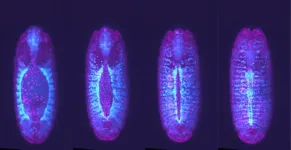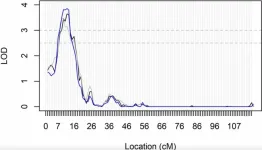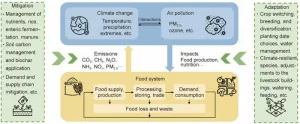(Press-News.org) In developing hearts, cells shuffle around, bumping into each other to find their place, and the stakes are high: pairing with the wrong cell could mean the difference between a beating heart and one that falters. A study publishing on March 12 in the Cell Press journal Biophysical Journal demonstrates how heart cells go about this “matchmaking” process. The researchers model the intricate movements of these cells and predict how genetic variations could disrupt the heart development process in fruit flies.
In both humans and fruit flies, the heart’s tissues arise from two distinct regions of the embryo, which are initially far apart. As development progresses, these cells journey toward each other, ultimately merging into a tube-like shape that will become the heart. For the heart to develop correctly, these cells must align and pair up precisely.
“As the cells come together, they jiggle and adjust, and somehow always end up pairing with a heart cell of the same type,” says the lead author, Timothy Saunders (@TimESaunders) of the University of Warwick. This observation inspired the team to explore how cells match up in the first place and how they know when they’ve found the right fit.
Developing heart cells have tentacle-like protrusions called filopodia, which probe and grab onto potential partners. Saunders’ previous work found that proteins create waves that pull mismatched cells apart, giving them another chance to find the right match.
“It’s basically like cells are speed dating,” says Saunders. “They have just a few moments to determine if they’re a good match, with molecular ‘friends’ ready to pull them apart if they’re not compatible.”
The researchers found that heart cells seek stability where they remain closest to stillness—like a rolling ball that eventually comes to a stop, known as energy equilibrium in physics. In developing heart cells, this principle applies when cells find a balance between connection forces and their ability to adjust to strain—also known as adhesive energy and elasticity. Based on this observation, the team developed a model that shows how cells can self-organize.
Next, the team tested their model on fruit fly hearts with mutations and misalignments. By calculating the adhesive energy between different cell types and assessing tissue elasticity, the model predicted how cells would match and rearrange.
“Although rare, sometimes the heart tube ends up with one cell on one side when it should have two, or two cells when there should be four,” says Saunders. “We could input these imperfections into the model and run it.” The model produced outcomes that closely mirrored what was observed in real embryos.
The team notes that their model not only enhances our understanding of how cells match and align during heart development but also has broader applications. Similar cell-matching processes are crucial in neuronal connections, wound repair, and facial development, where hiccups can lead to conditions like cleft lip.
“Essentially, we’re putting numbers to biological processes to explain what we observe,” Saunders adds.
###
This research was supported by funding from the University of Warwick, EMBO Global Investigator, Singapore Ministry of Education Academic Research Fund, Singapore National Research Foundation Fellowship, HFSP Young Investigator grant, and British Heart Foundation research grant.
Biophysical Journal, Saunders et al., “Interfacial energy constraints are sufficient to align cells over large distances” https://www.cell.com/biophysj/fulltext/S0006-3495(25)00102-X
Biophysical Journal (@BiophysJ), published by Cell Press for the Biophysical Society, is a bimonthly journal that publishes original research and reviews on the most important developments in modern biophysics—a broad and rapidly advancing field encompassing the study of biological structures and focusing on mechanisms at the molecular, cellular, and systems levels through the concepts and methods of physics, chemistry, mathematics, engineering, and computational science. Visit: http://www.cell.com/biophysj/home. To receive Cell Press media alerts, contact press@cell.com.
END
Study compares those with food insecurity to food-secure individuals over 20 years
Food insecurity is associated with a 41% increased risk of heart disease over time
Findings suggest food security screening as a key tool to prevent heart disease
CHICAGO --- Struggling to afford food today could mean heart problems tomorrow. Young adults experiencing food insecurity have a 41% greater risk of developing heart disease in midlife, even after accounting for demographic and socioeconomic factors, according to a new Northwestern Medicine study. Food insecurity — struggling to get enough nutritious ...
About The Study: In this prospective cohort study among participants in the Coronary Artery Risk Development in Young Adults (CARDIA) study, food insecurity was associated with incident cardiovascular disease (CVD) even after adjustment for socioeconomic factors, suggesting that food insecurity may be an important social deprivation measure in clinical assessment of CVD risk. Whether interventions to reduce food insecurity programs can potentially alleviate CVD should be further studied.
Corresponding Author: To contact the corresponding author, Jenny Jia, MD, MSc, email jenny.jia@northwestern.edu.
To access the embargoed study: ...
About The Study: This cohort study found that healthier diets and lower waist to hip ratio throughout midlife were associated with better brain and cognitive health in older age. The findings suggest that interventions to improve diet and manage central obesity might be most effective between ages 48 and 70.
Corresponding Author: To contact the corresponding author, Daria E. A. Jensen, DPhil, email jensen@cbs.mpg.de.
To access the embargoed study: Visit our For The Media website at this link https://media.jamanetwork.com/
(doi:10.1001/jamanetworkopen.2025.0171)
Editor’s Note: Please see the article for additional information, ...
Background and objectives
Gastrointestinal endoscopy has revolutionized the entire practice of gastroenterology worldwide, including Nigeria. Endoscopy was introduced in Nigeria more than four decades ago, and it has been a story of varying successes and challenges. This study explored the various experiences of endoscopists, the challenges they face, and the efforts put in place to maintain the practice in Nigeria.
Methods
This cross-sectional survey was conducted from October to December 2023 among endoscopists practicing ...
Toronto, ON, March 12, 2025—Transgender and gender diverse individuals who were hospitalized for psychiatric care were less likely to have a follow-up visit compared to the general population, suggesting they face transphobia in the hospital system.
In a new study from ICES and the Centre for Addiction and Mental Health (CAMH), findings demonstrate that transgender and gender diverse (TGD) people face an interesting paradox: they have lower access to appropriate mental health care and support following a psychiatric hospitalization, yet have better follow-up after an emergency department (ED) visit. According to Statistics Canada, TGD people account ...
“Notably, the findings from this work may provide novel insight into the underlying mechanisms of PAD and, perhaps, have prevention or therapeutic impacts.”
BUFFALO, NY — March 12, 2025 — A new research paper was published in Aging (Aging-US) on February 25, 2025, Volume 17, Issue 2, titled “Epidemiology and genetic determination of measures of peripheral vascular health in the Long Life Family Study.”
Researchers from multiple institutions, led by first author and corresponding author ...
A recent review published in Engineering delves into the complex relationships among food systems, climate change, and air pollution, highlighting the need for sustainable strategies to address these interconnected global challenges.
Climate change and air pollution pose significant threats to food systems. Rising temperatures, altered precipitation patterns, and extreme weather events, driven by climate change, disrupt agricultural production. For example, higher temperatures and shifting precipitation patterns have altered crop growth cycles, caused yield fluctuations, and increased uncertainty ...
A recent study published in the journal Engineering delves into the application of tissue engineering in spinal cord injury (SCI) repair, presenting a comprehensive review of the latest research and potential treatment strategies.
SCI is a severe condition that affects the central nervous system, often leading to permanent loss of sensation and motor function. Current treatments, such as surgical decompression and drug therapy, can only alleviate symptoms to a certain extent, making it crucial to explore new therapeutic approaches. Tissue engineering, an interdisciplinary field integrating life science, material science, engineering technology, ...
A preclinical study by HSS investigators found that earlier anterior cruciate ligament (ACL) reconstruction led to lower immune cell activity, less inflammation and fewer joint changes associated with knee osteoarthritis compared to delayed surgery. The research team shared their study results today in a poster presentation at the American Academy of Orthopaedic Surgeons 2025 Annual Meeting.
After a knee injury, such as an ACL tear or rupture, immune cells travel to lymph nodes, where they interact with ...
INDIANAPOLIS – As many as half of nursing home residents are cognitively impaired and may be unable to communicate symptoms such as pain or anxiety to the staff and clinicians caring for them. Therefore, information needed for the evaluation of symptoms and subsequent treatment decisions typically does not reliably exist in nursing home electronic health records (EHRs).
A new paper reports on the novel adaptation of a commonly used symptom assessment instrument to more comprehensively acquire this difficult-to-obtain data with the ultimate goal of enabling knowledge-based expansion of palliative care services in nursing homes ...



